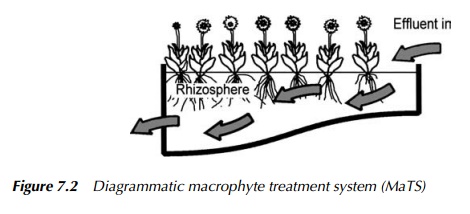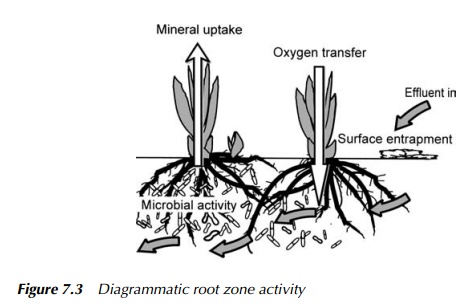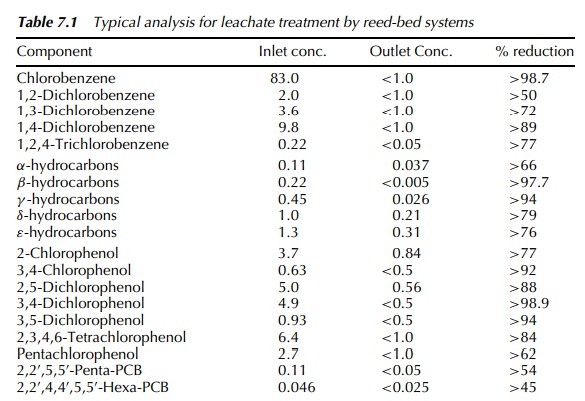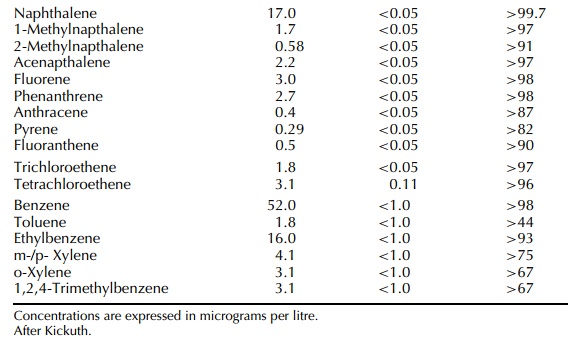Chapter: Environmental Biotechnology: Phytotechnology and Photosynthesis
Macrophyte Treatment Systems (MaTS)
Macrophyte Treatment Systems
(MaTS)
The discharge of wastewaters into natural watercourses, ponds and
wetlands is an ancient and long-established practice, though rising
urbanisation led to the development of more engineered solutions, initially for
domestic sewage and then later, industrial effluents, which in turn for a time
lessened the importance of the earlier approach. However, there has been a
resurgence of interest in simpler, more natural methods for wastewater
treatment and MaTS systems, in particular, have received much attention as a
result. While there has, undoubtedly, been a strong upsurge in public
understanding of the potential for environmentally har-monious water cleaning per se, a large part of the driving
force behind the newly found interest in these constructed habitats comes from
biodiversity concerns. With widespread awareness of the dwindling number of
natural wetlands, often a legacy of deliberate land drainage for development
and agricultural purposes, the value of such manufactured replacements has
become increasingly apparent. In many ways it is fitting that this should be
the case, since for the majority of aquatic macrophyte systems, even those
expressly intended as ‘monocultures’ at the gross scale, it is very largely as
a result of their biodiversity that they function as they do.
These treatment systems,
shown diagrammatically in Figure 7.2, are charac-terised by the input of
effluent into a reservoir of comparatively much larger vol-ume, either in the
form of an artificial pond or an expanse of highly saturated soil

held within a containment layer, within which the macrophytes have
been estab-lished. Less commonly, pre-existing natural features have been used.
Although wetlands have an innate ability to accumulate various unwanted
chemicals, the concept of deliberately polluting a habitat by using it as a
treatment system is one with which few feel comfortable today. A gentle
hydraulic flow is estab-lished, which encourages the incoming wastewater to
travel slowly through the system. The relatively long retention period that
results allows adequate time for processes of settlement, contaminant uptake,
biodegradation and phytotransformation to take place.
The mechanisms of pollutant
removal are essentially the same, irrespective of whether the particular
treatment system is a natural wetland, a constructed monoculture or polyculture
and independent of whether the macrophytes in question are submerged, floating
or emergent species. Both biotic and abiotic methods are involved. The main
biological mechanisms are direct uptake and accumulation, performed in much the
same manner as terrestrial plants. The remainder of the effect is brought about
by chemical and physical reactions, principally at the interfaces of the water
and sediment, the sediment and the root or the plant body and the water. In
general, it is possible to characterise the primary processes within the MaTS
as the uptake and transformation of contaminants by micro-organisms and plants
and their subsequent biodegra-dation and biotransformation; the absorption,
adsorption and ion exchange on the surfaces of plants and the sediment; the
filtration and chemical precipita-tion of pollutants via sediment contact; the
settlement of suspended solids; the chemical transformation of contaminants. It
has been suggested that although settlement inevitably causes the accrual of
metals, in particular, within the sed-iment, the plants themselves do not tend
to accumulate them within their tis-sues. While this appears to be borne out,
particularly by original studies of natural wetlands used for the discharge of
mine washings (Hutchinson 1975), this does not form any basis on which to
disregard the contribution the plants make to water treatment. For one thing,
planting densities in engineered sys-tems are typically high and the species
involved tend to be included solely for their desired phytoremediation
properties, both circumstances seldom repeated in nature. Moreover, much of the
biological pollutant abatement potential of the system exists through the
synergistic activity of the entire community and, in purely direct terms, this
largely means the indigenous microbes. Functionally, there are strong parallels
between this and the processes of enhanced rhizo-spheric biodegradation
described for terrestrial applications. While exactly the same mechanisms are
available within the root zone in an aquatic setting, in addition, and
particularly in the case of submerged vegetation, the surface of the plants
themselves becomes a large extra substrate for the attached growth of closely
associated bacteria and other microbial species. The combined rhizo- and circum-phyllo-
spheres support a large total microbial biomass, with a distinctly different
compositional character, which exhibits a high level of bioactivity, rel-ative
to other microbial communities. As with rhizodegradation on dry land, part of
the reason is the increased localised oxygenation in their vicinity and the
corresponding presence of significant quantities of plant metabolic exudates,
which, as was mentioned in the relevant earlier section, represents a major
pro-portion of the yearly photosynthetic output. In this way, the main role of
the macrophytes themselves clearly is more of an indirect one, bringing about
local environmental enhancement and optimisation for remediative microbes,
rather than being directly implicated in activities of primary biodegradation.
In addi-tion, physico-chemical mechanisms are also at work. The iron plaques
which form on the plant roots trap certain metals, notably arsenic (Otte,
Kearns and Doyle 1995), while direct adsorption and chemical/biochemical
reactions play a role in the removal of metals from the wastewater and their
subsequent retention in sediments.
The ability of emergent
macrophytes to transfer oxygen to their submerged portions is a
well-appreciated phenomenon, which in nature enables them to cope with
effective waterlogging and functional anoxia. As much as 60% of the oxygen
transported to these parts of the plant can pass out into the rhizosphere,
creating aerobic conditions for the thriving microbial community associated
with the root zone, the leaf surfaces and the surrounding substrate. This
accounts for a significant increase in the dissolved oxygen levels within the
water generally and, most particularly, immediately adjacent to the macrophytes
themselves.
The aerobic breakdown of
carbon sources is facilitated by this oxygen transfer, for obvious reasons, and
consequently it can be seen to have a major bearing on the rate of organic
carbon biodegradation within the treatment system, since its adequate removal
requires a minimum oxygen flux of one and a half times the input BOD loading.
Importantly, this also makes possible the direct oxida-tion of hydrogen
sulphide (H2S) within the root zone and, in some cases, iron and manganese.
While from the earlier
investigations mentioned on plant/metal interactions (Hutchinson 1975) their
direct contribution to metal removal is small, fast-growing macrophytes have a
high potential uptake rate of some commonly encountered effluent components.
Some kinds of water hyacinth, Eichhornia
spp., for example, can increase their biomass by 10 g/m2/day under optimum
conditions, which represents an enormous demand for nitrogen and carbon from
their environment. The direct uptake of nitrogen from water by these floating
plants gives them an effective removal potential which approaches 6000 kg per
hectare per year and this, coupled with their effectiveness in degrading
phenols and in reducing copper, lead, mercury, nickel and zinc levels in
effluents, explains their use in bioengineered treatment systems in warm climates.
Emergent macrophytes are also particularly
efficient at removing and storing nitrogen in their roots, and some can do the
same for phosphorus. However, the position of this latter contaminant in
respect of phytotreatment in general is less straightforward. In a number of
constructed wetland systems, though the overall efficacy in the reduction of
BOD, and the removal of nitrogenous com-pounds and suspended solids has been
high, the allied phosphorus components have been dealt with much less effectively.
This may be of particular concern if phosphorus-rich effluents are to be
routinely treated and there is a consequent risk of eutrophication resulting.
It has been suggested that, while the reasons for this poor performance are not
entirely understood, nor is it a universal finding for all applications of
phytotreatment, it may be linked to low root zone oxygena-tion in slow-moving
waters (Heathcote 2000). If this is indeed the case, then the preceding
discussion on the oxygen pump effect of many emergent macrophytes has clear
implications for biosystem design.
As has been established
earlier, associated bacteria play a major part in aquatic plant treatment
systems and microbial nitrification and denitrification processes are the major
nitrogen-affecting mechanisms, with anaerobic denitrification, which typically
takes place in the sediment, causing loss to atmosphere, while aerobic
nitrification promotes and facilitates nitrogenous incorporation within the
vegeta-tion. For the effective final removal of assimilated effluent
components, accessibly harvestable material is essential, and above water,
standing biomass is ideal.
The link between the general
desire for biodiversity conservation and the acceptability of created wetlands
was mentioned earlier. One of the most impor-tant advantages of these systems
is their potential to create habitats not just for ‘popular’ species, like
waterfowl, but also for many less well-known organ-isms, which can be
instrumental in bolstering the ecological integrity of the area. This may be of
particular relevance in industrial or urban districts. At the same time, they
can be ascetically pleasing, enhancing the landscape while per-forming their
function. These systems can have relatively low capital costs, but inevitably every
one must be heavily site specific, which means many aspects of the
establishment financing are variable. However, the running costs are gener-ally
significantly lower than for comparable conventional treatment operations of
similar capacity and efficacy. In part the reason for this is that once
properly set up, a well-designed and constructed facility is almost entirely
self-maintaining. However, the major contribution to low operational overheads
comes from the system’s low energy requirements, since gravity drives the water
flow and all the remediating organisms are ultimately solar powered, either
directly or indirectly, via the photosynthetic action of the resident
autotrophe community.
Aside of cost and amenity
grounds, one major positive feature is that the efflu-ent treatment itself is
as good or better than that from conventional systems. When correctly designed,
constructed, maintained and managed, plant-based treatment is a very efficient
method of ameliorating wastewaters from a wide range of sources and in
addition, is very tolerant of variance in organic loadings and effluent
quality, which can cause problems for some of the alternative options. In
addition, phyto-systems can often be very effective at odour reduction, which
is often a major concern for the producers and processors of effluents rich in
biodegradable substances.
Invariably, the better
designed, the easier the treatment facility is to manage and in most cases,
‘better’ means simpler in practice, since this helps to keep the maintenance
requirement to a minimum and makes maximum use of the existing topography and
resources. Provision should also be made for climatic factors and most
especially, for the possibility of flooding or drought. It is imperative that
adequate consideration is given to the total water budget at the project
planning stage. Although an obvious point, it is important to bear in mind that
one of the major constraints on the use of aquatic systems is an adequate
supply of water throughout the year. While ensuring this is seldom a problem
for temperate lands, for some regions of the world it is a significant concern.
Water budgeting is an attempt to model the total requirement, accounting for
the net overall in- and out-puts, together with the average steady-state volume
resident within the system in operation. Thus, effluent inflow, supplementary
‘clean’ water and rainfall need to be balanced against off-take, evaporative
and transpirational losses and the demands of the intended retention time
required to treat the particular contami-nant profile of a given wastewater.
One apparent consideration in this process is the capacity of the facility.
Determining the ‘required’ size for a treatment wet-land is often complicated
by uncertainty regarding the full range of wastewater volumes and component
character likely to be encountered over the lifetime of the operation. The
traditional response to this is to err on the side of caution and oversize,
which, of course, has inevitable cost implications, but in addition, also
affects the overall water budget. If the effluent character is known, or a
sample can be obtained, its BOD can be found and it is then a relatively simple
pro-cedure to use this to calculate the necessary system size. However, this
should only ever be taken as indicative. For one thing, bioengineered treatment
systems typically have a lifespan of 15 – 20 years and the character of the
effluent being treated may well change radically over this time, particularly
in response to shifts in local industrial practice or profile. In addition,
though BOD assessment is a useful point of reference, it is not a uniform
indicator of the treatment require-ments of all effluent components. For the
bioamelioration process to proceed efficiently, a fairly constant water level
is necessary. Although the importance of this in a drought scenario is
self-evident, an unwanted influx of water can be equally damaging, disturbing
the established equilibrium of the wetland and pushing contaminants through the
system before they can be adequately treated. Provision both to include
sufficient supplementary supplies, and exclude surface water, is an essential
part of the design process.
One aspect of system design
which is not widely appreciated is the importance of providing a substrate with
the right characteristics. A number of different materials have been used with
varying degrees of success, including river sands, gravels, pulverised clinker,
soils and even waste-derived composts, the final choice often being driven by
issues of local availability. The main factors in determining the suitability
of any given medium are its hydraulic permeability and absorbance potential for
nutrients and pollutants. In the final analysis, the sub-strate must be able to
provide an optimum growth medium for root development while also allowing for
the uniform infiltration and through-flow of wastewater. A hydraulic
permeability of between 10−3 and 10−4 m/s is generally accepted as ideal, since
lower infiltration tends to lead to channelling and flow reduction, both of
which severely restrict the efficiency of treatment. In addition, the chemical
nature of the chosen material may have an immediate bearing on system efficacy.
Soils with low inherent mineral content tend to encourage direct nutrient uptake
to make good the deficiency, while highly humeric soils have been shown to have
the opposite effect in some studies. The difficulties sometimes encountered in
relation to phosphorus removal within wetland systems have been mentioned
earlier. The character of the substrate medium can have an important influence
on the uptake of this mineral, since the physico-chemical mechanisms
responsi-ble for its abstraction from wastewater in an aquatic treatment system
relies on the presence of aluminium or iron within the rhizosphere. Obviously,
soils with high relative content of these key metals will be more effective at
removing the phosphate component from effluent, while clay-rich substrates tend
to be better suited to lowering heavy metal content.

One aspect of system design which is not widely appreciated is the importance of providing a substrate with the right characteristics. A number of different materials have been used with varying degrees of success, including river sands, gravels, pulverised clinker, soils and even waste-derived composts, the final choice often being driven by issues of local availability. The main factors in determining the suitability of any given medium are its hydraulic permeability and absorbance potential for nutrients and pollutants. In the final analysis, the sub-strate must be able to provide an optimum growth medium for root development while also allowing for the uniform infiltration and through-flow of wastewater. A hydraulic permeability of between 10−3 and 10−4 m/s is generally accepted as ideal, since lower infiltration tends to lead to channelling and flow reduction, both of which severely restrict the efficiency of treatment. In addition, the chemical nature of the chosen material may have an immediate bearing on system efficacy. Soils with low inherent mineral content tend to encourage direct nutrient uptake to make good the deficiency, while highly humeric soils have been shown to have the opposite effect in some studies. The difficulties sometimes encountered in relation to phosphorus removal within wetland systems have been mentioned earlier. The character of the substrate medium can have an important influence on the uptake of this mineral, since the physico-chemical mechanisms responsi-ble for its abstraction from wastewater in an aquatic treatment system relies on the presence of aluminium or iron within the rhizosphere. Obviously, soils with high relative content of these key metals will be more effective at removing the phosphate component from effluent, while clay-rich substrates tend to be better suited to lowering heavy metal content.
Engineered reed beds are probably the most familiar of all macrophyte treat-ment systems, with several high profile installations in various parts of the globe having made the technology very widely accessible and well appreciated. This approach has been successfully applied to a wide variety of industrial effluents, in many different climatic conditions and has currently been enjoying consider-able interest as a ‘green’ alternative to septic tanks for houses not joined up to mains sewerage. At its heart is the ability of reeds, often established as mono-cultures of individual species, or sometimes as oligocultures of a few, closely related forms, to force oxygen down into the rhizosphere, as has been previously discussed. Many examples feature Phragmites or Typha species, which appear to be particularly good exponents of the oxygen pump, while simultaneously able to support a healthy rhizospheric microfloral complement and provide a stable root zone lattice for associated bacterial growth and physico-chemical process-ing of rhizo-contiguous contaminants. Isolated from the surrounding ground by an impermeable clay or polymer layer, the reed bed is almost the archetypal emergent macrophyte treatment system.


The mechanisms of action are
shown in Figure 7.3 and may be categorised as surface entrapment of any solids
or relatively large particulates on the grow-ing medium or upper root surface.
The hydraulic flow draws the effluent down through the rhizosphere, where the
biodegradable components come into direct contact with the root zone’s
indigenous micro-organisms, which are stimulated to enhanced metabolic activity
by the elevated aeration and greater nutrient availability. There is a net
movement of oxygen down through the plant and a corresponding take-up by the
reeds of nitrates and minerals made accessible by the action of nitrifying and
other bacteria.
These systems are very
efficient at contamination removal, typically achieving 95% or better
remediation of a wide variety of pollutant substances, as demon-strated in
Table 7.1, which shows illustrative data on the amelioration of landfill
leachates by this system.
Nevertheless, reed beds and
root zone treatment techniques in general are not immune from a range of
characteristic potential operational problems, which can act to limit the
efficacy of the process. Thus, excessive waterlogging, surface run-off, poor or
irregular substrate penetration and the development of preferential drainage
channels across the beds may all contribute to a lessening of the system’s
performance, in varying degrees.
Related Topics